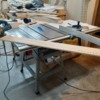I plan to use a good bit of Gargraves flex for my curves. I have experience with flex track in smaller scales, and don't think I'll have too much trouble with Gargraves. I have access to both the "belly" and "water tank" methods ;-) My question is regarding the last few inches if the track. Is there any issues getting that last few inches curved properly? How can you best avoid getting slightly straight(er) ends at the joints between rail sections?
It's the hardest part, and of course you'll be trimming the rails at the end. I suspect that I probably didn't get much of mine "perfect", but it works well and looks good, so I'm happy. ![]() I just walked around and sighted down some of the curves, I think I may have done better than I expected with the ends. That being said, it can't be that difficult if I did it.
I just walked around and sighted down some of the curves, I think I may have done better than I expected with the ends. That being said, it can't be that difficult if I did it. ![]()
![]()
I use the DRILL MASTER 6 in. 5.5 Amp Cut-Off Saw from Harbor Freight to square the ends, I bought it when it was on sale for $30. The trick with this tool is to cut slow and don't force it, and you get pretty clean cuts that require minimal dressing up.

Attachments
@G3750 posted:
Thanks George!
I am going to run down the basement and try that right now.
=============================================================================
Oh No !! ![]()
John
Attachments
Just amazing, who would a thunk. You would hope no one gets hurt bending track. IMO, Mike CT.
I did the same thing that John did many years ago with excellent results. I made templates out of plywood with the different sizes. I would make the template smaller than the actual curve to allow for spring back and they always spring back to some degree and you want your final product not to have any stress on it. So I did maybe an 065 for an 072 curve and if the spring back didn't open all the way to 072, I helped it a little and at that point it would stay there forever. Mark your sizes on the template pieces. JP
I found this idea during a search of the forum a while back. Seems like a good way to bend flex track. Patterns are cut with the inside radius on the outside, and the outside radius is cut on the inside. Radius are determined on the ends of the ties.
A trammel makes quick work of patterns.
Attachments
I've had limited success using most of the techniques suggested. The WD works great loosening up the ties, but you have to let it sink in for a while, and then work the ties prior to bending. And I found out after putting a few small kinks in the track that the ties need to be evenly distributed. So I had to keep rearranging them as I proceeded.
I started out using the "belly" technique, as suggested, but the bends weren't evenly forming. However, I found the water heater technique works great! So thank you all for your valuable help. Other than that, I'm sure I would have ruined the track.
@Craftech posted:
Now... That was FUNNY! 

Sometimes you do need a sharp 90 degree turn!
There's always one. ![]()
George
Trainmasters TV had a number of segments regarding getting flextrack to conform and hold specific radii and different shapes and they did it on the benchwork. I believe the segments are called "Back to the Basement" Miles was demonstrating using a block type tool machined for fitting the rails. He noted they were available in all scales up through "G".
Just a thought.
I'm still (not) trying to picture John's O72 belly![]() .
.
This is why I had to stick to O72 and larger curves! ![]()
![]()

Attachments
Hilarious comedy club material. Love this thread.
John
I would think the flatter the belly the wider the curve. So it really is a function of how many beers it takes to get the proper curve. Sounds like a fun project ![]()
Does that mean large layouts require a lot of beer to construct? ![]()
![]()
![]()
Attachments
Hello John H., You could have used Genesee or Utica Club.
It's not so easy to "get to the other side of the river" these days!
John N. (Grew up in Syracuse and lived in Orchard Park)
@gunrunnerjohn posted:Does that mean large layouts require a lot of beer to construct?


Confucius say,
"It not beer that suggest large belly, it food on keyboard"
John
Actually, Labatt is part of North American Breweries, which also owns Genesee. My son in law is regional Vice President for NAB, so life is good!















